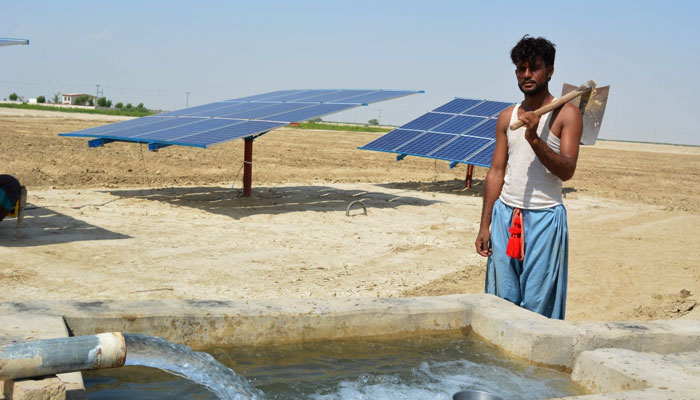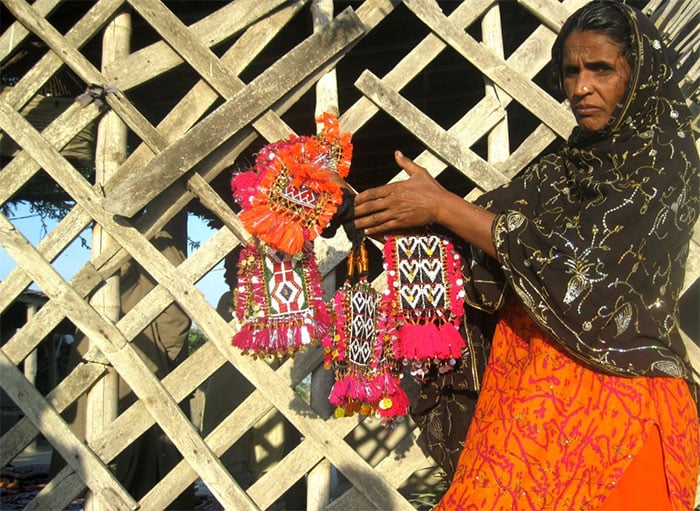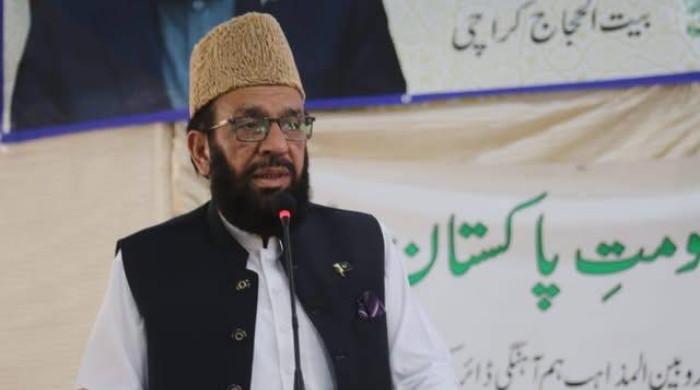Villages in Sindh light up with solar power
'Many villages in Sindh are switching to solar power, as it is affordable'
December 27, 2019

Sabhagi Dablo rushes me to the courtyard of her mud brick home. There, she proudly points towards a large blue and white panel that sticks out rather awkwardly from its surrounding.
“I sold my goat and bought a solar panel,” the mother of six explains enthusiastically, “Now, I can light the bulbs in my house at least. There are no electricity problems anymore.”
Dablo lives in a small fishing hamlet in Thatta, around 110 kilometers from Karachi, Pakistan’s port city. She, and the other women like her, had lived in darkness for too long. The electric infrastructure of the village was old and unrepaired. Most of the village only received power in the mornings and that too for a few hours. Nights were pitch black and cold.
“My husband, like other residents of this village, is a fisherman,” Dablo explains over a cup of tea,
“There are days that he is not able to make a single catch.” In order to contribute to the finances of the house, and to feed her children, Dablo took up stitching. The only time she would get to work was at night, when her family had gone to sleep and she was done with household chores. “But usually there would be no light to work under.”
Fed up, she sold one of her goats for Rs16,000 and used the money to invest in a small solar power station. Its panels convert radiation from sunlight into electricity, powering her home. Now, Dablo, and other women from her village, gather in her courtyard every other night to embroidery bed linens, quilts and clothes, which can be sold in the local market.

In fact in this tiny village in Sindh, women are leading the way towards rural electrification, through clean and renewable sources of energy.
In recent years, the delta of the Indus River, once the fifth largest in the world, has suffered immensely due to the building of dams and barrages upstream. This has had a devastating effect on the lifeline of poor farming and fishing communities located along the river’s stretch.
“Our agriculture lands have become unfertile and there is no fish in the river,” Dablo explains, “due to which several fishermen have migrated to other areas. But people like us, who are too poor to move, have no choice but to live through hard times.” Her village not only lacks electricity, it also does not have basic infrastructure, such as roads, portable water and healthcare.
Life in these remote communities is difficult, which is why says Sultan Ahmed, a social worker in the Thatta district, the small solar panels are a “God-sent miracle”. They are changing living conditions in impoverish villages that have limited access to the country’s electric power system.
"Many villages in Sindh are now switching to solar power, as it is affordable,” said Ahmed.
Pakistan suffered a severe power crises in the last decade, forcing it to explore other means of producing energy. Power outages of over 10 hours or 16 hours were reported daily across the country. As a result, the demand for solar panels grew exponentially.
Today, most city-dwellers still choose to rely on traditional energy, but rural villages, especially in Sindh, are taking a new approach to power. According to Karachi’s Electronics Dealers Association, on average around 15 containers of solar panels, batteries and convectors arrive at the city’s port every day from China. Out of the stock, 75 per cent is sold to rural areas. In Dablo’s neighborhood alone, many homes have set up panels on roofs to power mobile phones, fans and lightbulbs.
Since Pakistan is one of the most vulnerable countries to climate change, solar stations are a greener and cleaner way of producing energy, which is why it has also caught the government’s attention.
Naeem Uddin Khan, the CEO of Limitless Solutions, one of the pioneer companies in Pakistan selling solar equipment, said that until recently substandard solar power stations were being imported into the country. This, he adds, was a big problem. These panels would often stop functioning a few days after purchase, and none had any warranty accompanying them.
To ensure quality products are sold in market, the federal government stepped up and set up a Pre Shipment Inspection (PSI), which requires solar companies to inspect solar stations at the point of purchase. “At the moment, over 90 per cent of our solar equipment is being imported from China,” said Khan.
In addition, to further facilitate the market, Pakistan has introduced an Alternative Energy Policy 2019, which sets aggressive targets of at least 20 per cent renewable energy generation by year 2025 out of its total energy generation, and 30 per cent by 2030.
The Alternative Energy Development Board, in support with the World Bank, has established nine ground-based solar measurement stations across the country, including in Bahawalpur, Islamabad, Lahore, Multan, Karachi, Quetta and Khuzdar.
In southern Sindh, 14,222 LED have been installed on street lights in the Hyderabad, Shaheed Benazirabad, Mirpurkhas, Larkana and Sukkur districts. While, 350 primary schools have been solarised in the Thar desert alone. Not only that, the Sindh government has announced a 400MW solar power plant in the Jamshoro district, which would be completed by 2023. "This project with the cost of $250 million will start supplying power to the national power grid by 2023-24,” said Sindh Solar Energy Project (SSEP) Project Director Mehfooz Qazi.
If the trajectory continues, Pakistan could be well on course to achieve its solar energy benchmarks, with a little help from women like Dablo.
This story was covered as part of the Clean Energy Wire (CLEW) fellowship.











